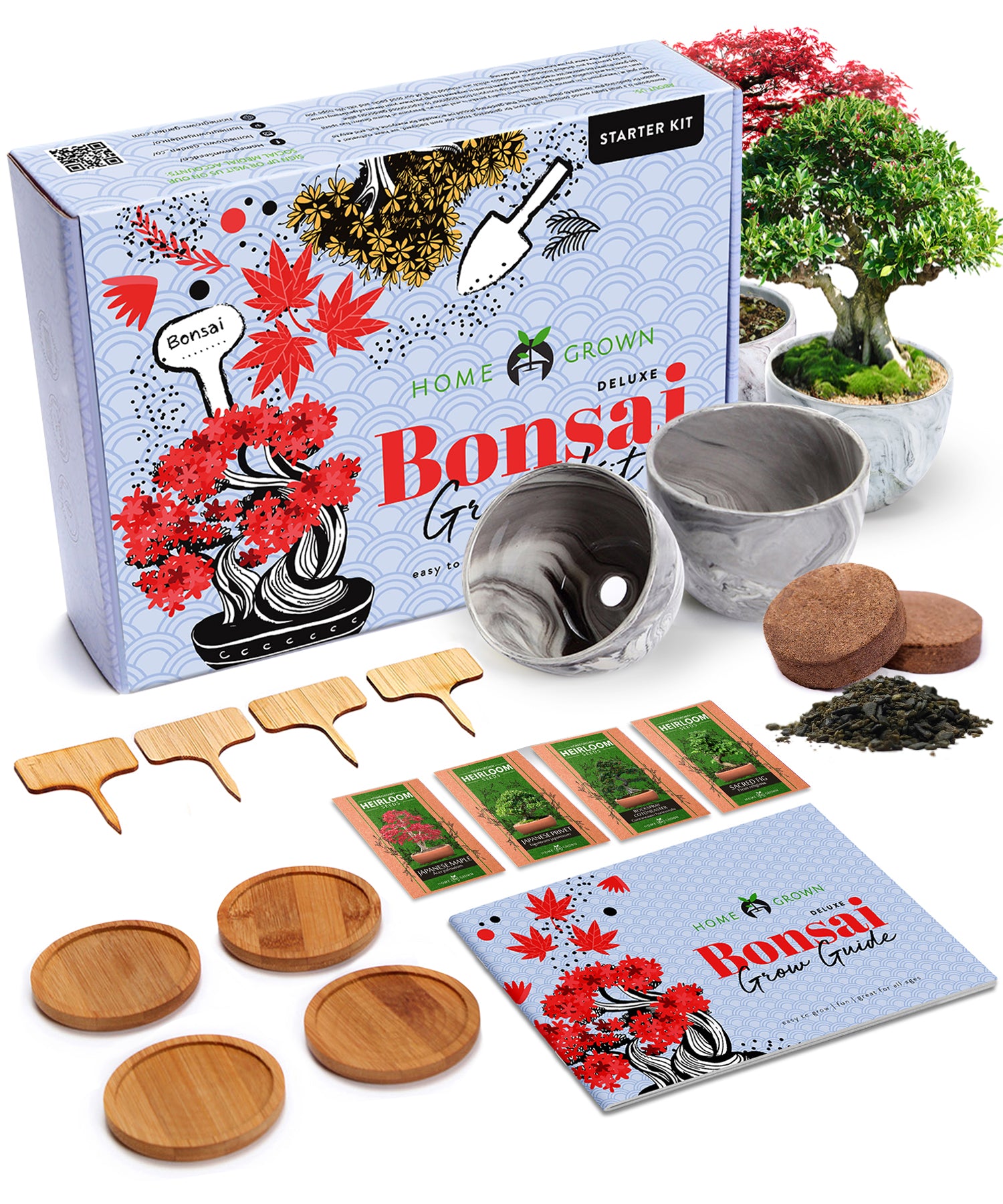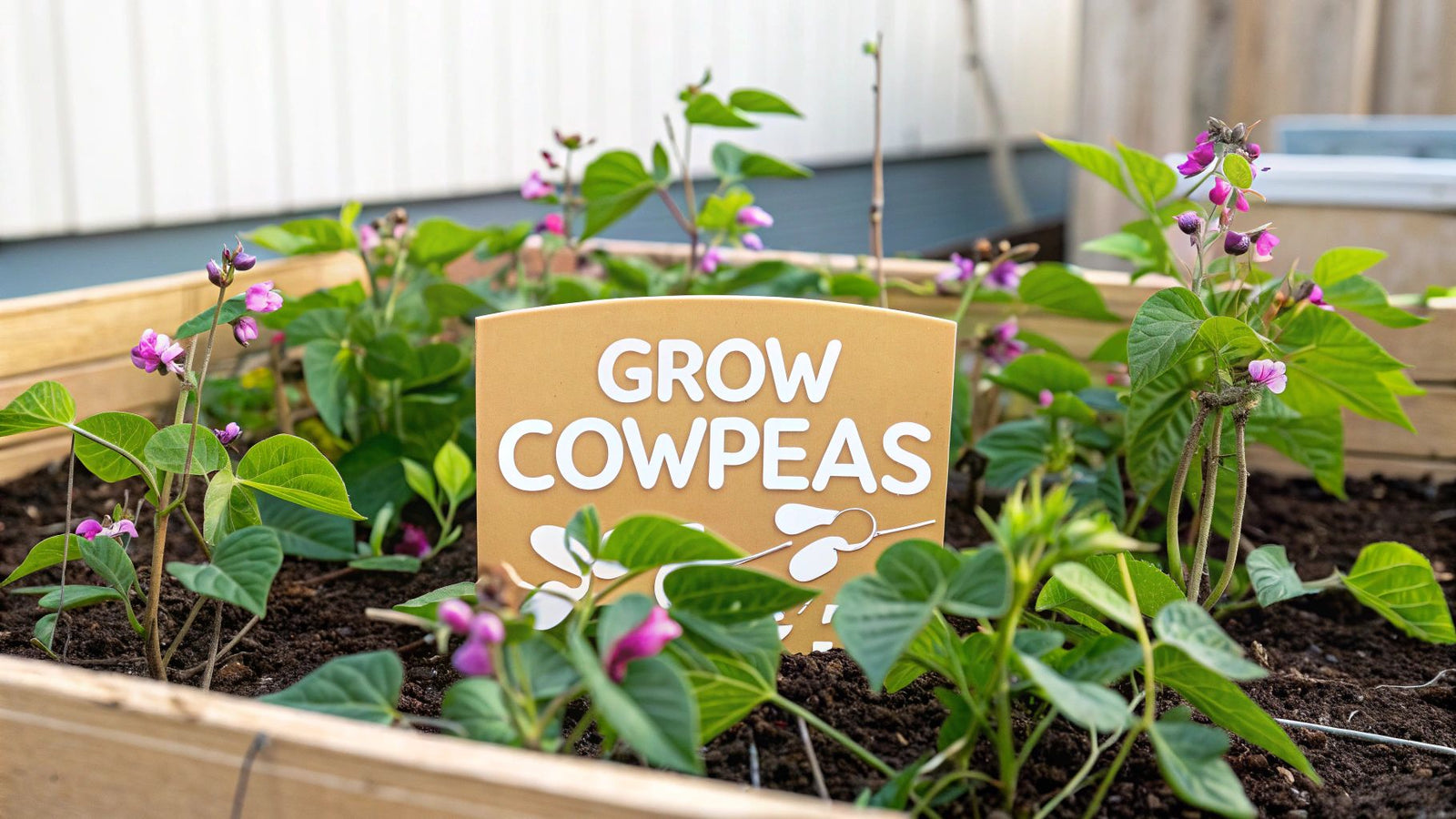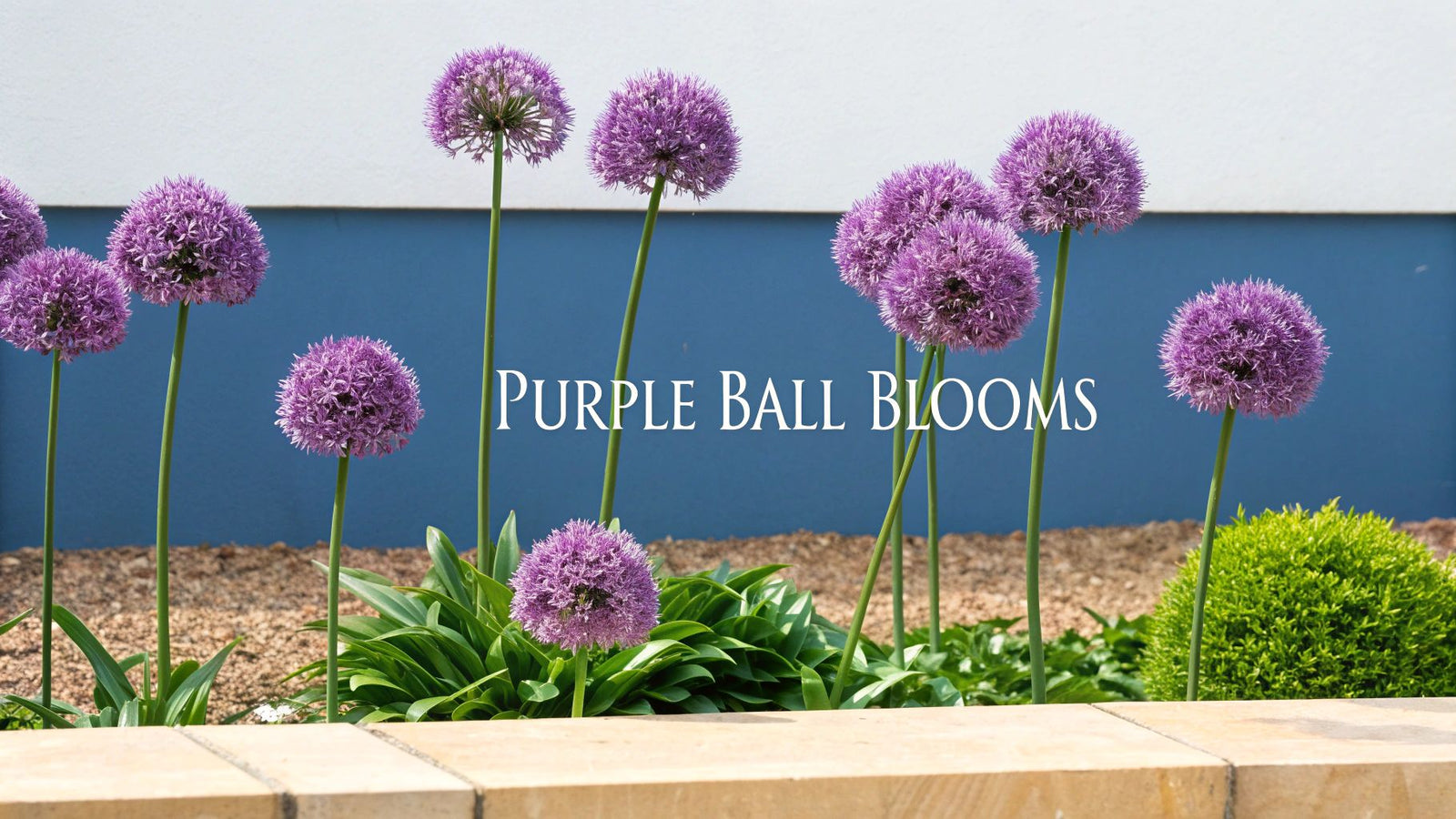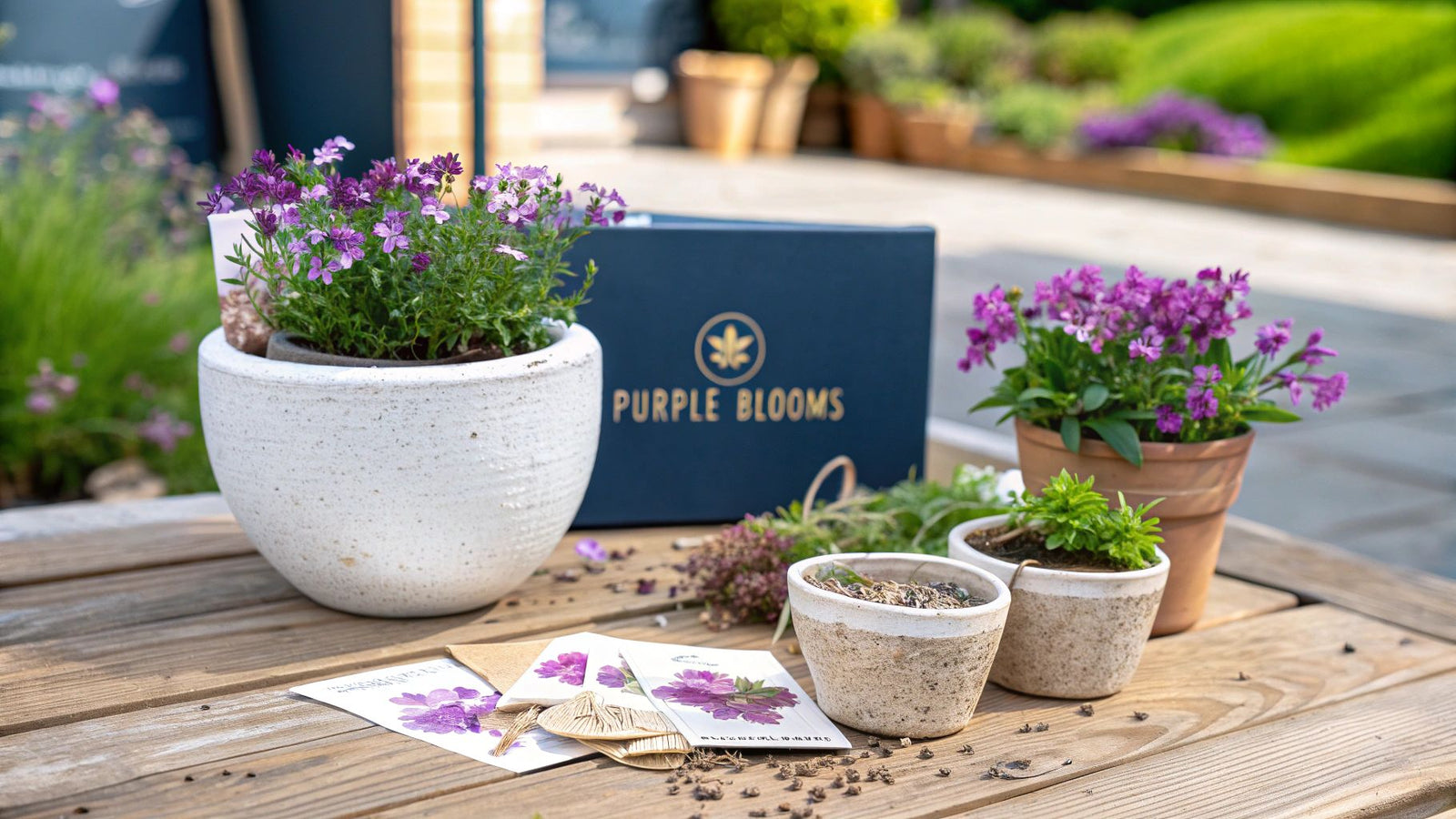
Adding a splash of purple to your garden brings depth, mystery, and a touch of royalty. You don't need large, dramatic blossoms to make an impact; the world of small purple flowers offers a unique charm, creating delicate tapestries of color that can fill borders, spill from containers, and attract essential pollinators. This guide focuses on six incredible plants renowned for their delightful tiny blooms.
We will explore everything you need to know to successfully plant small purple flowers, providing detailed care instructions and actionable tips for each variety. This comprehensive list is designed to help you create a stunning and low-maintenance display, regardless of your experience level. Whether you're designing a sprawling landscape or enhancing a compact urban balcony, these selections are perfect for adding continuous color and life.
Inside this guide, you will discover:
- Sweet Alyssum: A fragrant groundcover perfect for edges.
- Lavender: Classic aromatic spikes that thrive in the sun.
- Catmint: A hardy perennial that pollinators adore.
- Verbena: Trailing varieties ideal for hanging baskets.
- Creeping Phlox: A vibrant, mat-forming spring bloomer.
- Johnny Jump Up: Cheerful, edible flowers with tri-color faces.
Get ready to transform your space with these six beautiful and easy-to-grow plants.
1. Sweet Alyssum (Lobularia maritima)
For those looking to plant small purple flowers that create a lush, fragrant carpet, Sweet Alyssum is an exceptional choice. This low-growing annual is celebrated for its dense clusters of tiny, delicate blooms that exude a sweet, honey-like scent. Native to the Mediterranean, it thrives in a variety of settings and blooms profusely from early spring right up until the first frost, offering months of continuous color.
Sweet Alyssum forms a mounding or trailing habit, making it incredibly versatile. It typically reaches a height of only 4 to 6 inches while spreading 6 to 12 inches wide. This compact size makes it a perfect candidate for the front of garden beds, lining pathways, or spilling gracefully over the edges of containers and hanging baskets. The purple varieties, such as 'Royal Carpet' or 'Violet Queen', provide a rich, deep hue that contrasts beautifully with brighter flowers.
Why Choose Sweet Alyssum?
The appeal of Sweet Alyssum lies in its easy-going nature and long-lasting performance. It’s a fantastic option for beginner gardeners as it establishes quickly from seed and requires minimal fuss. Its ability to attract beneficial insects, including pollinators like bees and hoverflies, also makes it a valuable addition to any vegetable garden or ecosystem-focused landscape.
Pro Tip: Plant Sweet Alyssum near patios, windows, or walkways where its delightful fragrance can be easily enjoyed throughout the blooming season.
Practical Tips for Growing Sweet Alyssum
To get the most from this charming plant, follow these simple guidelines:
- Sowing: Direct sow seeds in the garden after the last frost date. They need light to germinate, so gently press them into the soil surface rather than burying them.
- Soil and Sun: It prefers full sun to partial shade and requires well-draining soil. Poor drainage can lead to root rot.
- Maintenance: To encourage a continuous flush of blooms, trim the plant back by about one-third mid-season if it starts to look leggy or sparse. Regular watering is crucial, especially during hot, dry spells.
The following quick-reference guide summarizes the essential stats for growing Sweet Alyssum.
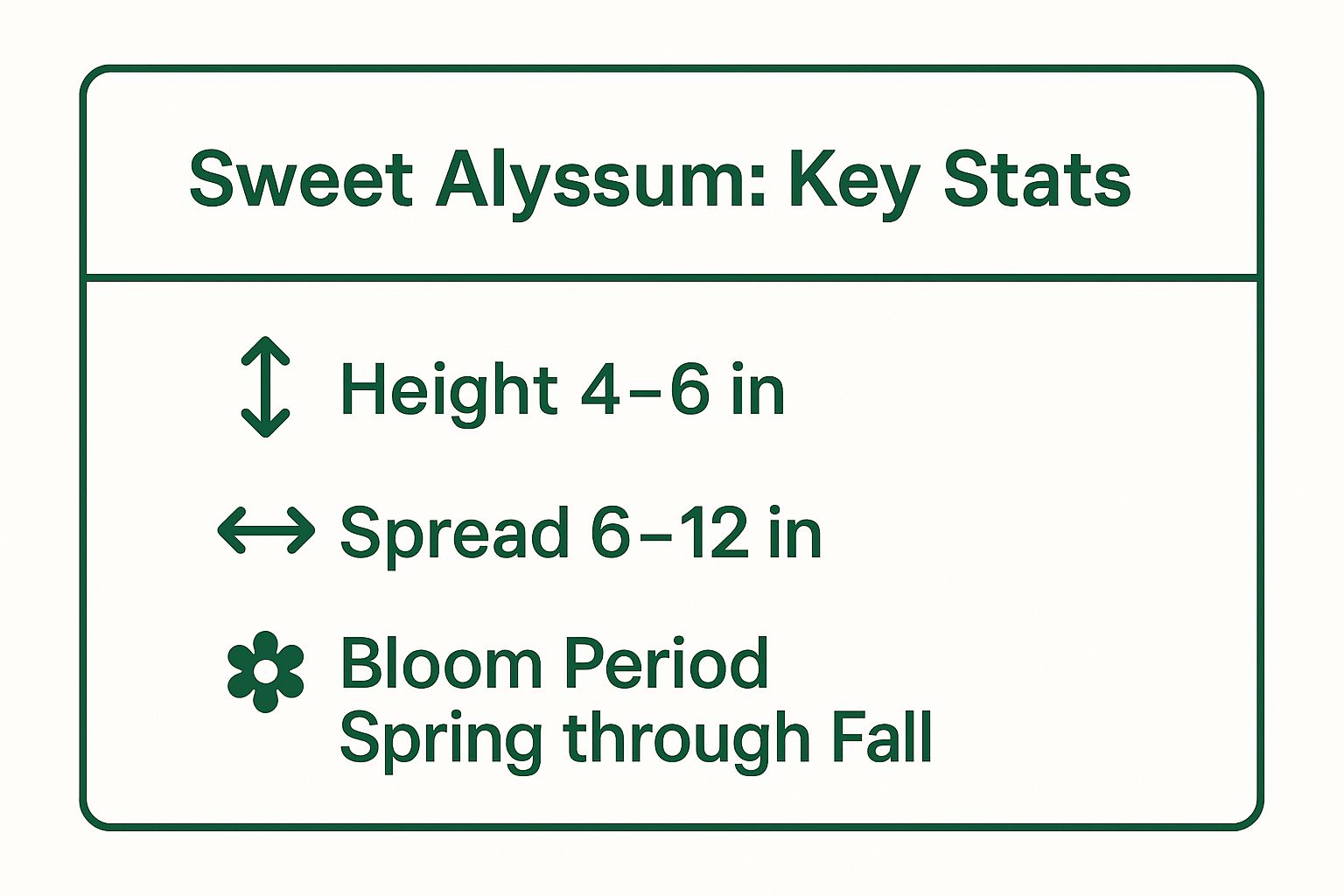
These key stats highlight just how adaptable and long-blooming Sweet Alyssum is, confirming its status as a low-maintenance ground cover or container filler. Its compact dimensions allow it to fit into nearly any garden design without overpowering neighboring plants.
2. Lavender (Lavandula species)
For those who want to plant small purple flowers that engage multiple senses, Lavender is an iconic and indispensable choice. This aromatic perennial herb is celebrated worldwide for its slender spikes of fragrant purple blooms and attractive, silvery-green foliage. A native of the Mediterranean, lavender has been cherished for centuries, from the ancient Romans to modern aromatherapy enthusiasts, for its calming scent, culinary versatility, and ornamental beauty.

Lavender species vary in size, but many compact varieties are perfect for smaller gardens, containers, or borders, typically growing between 1 to 3 feet tall. Its upright growth habit provides structure and a touch of Mediterranean elegance, famously seen in the rolling purple fields of Provence. Varieties like English lavender (Lavandula angustifolia) are known for their cold hardiness and sweet fragrance, making them a staple in classic cottage gardens.
Why Choose Lavender?
Lavender’s appeal extends far beyond its visual charm. It is a drought-tolerant, deer-resistant, and relatively low-maintenance plant once established, making it a practical choice for busy gardeners or those in dry climates. Its fragrant flowers are a magnet for pollinators like bees and butterflies, contributing to a healthy garden ecosystem, while its essential oils are known to repel mosquitoes and other pests.
Pro Tip: Harvest lavender stems just as the first few flowers open for the most potent fragrance. Tie them in bundles and hang them upside down in a dark, dry place to preserve them for sachets or culinary use.
Practical Tips for Growing Lavender
To cultivate healthy, fragrant lavender plants, keep these key guidelines in mind:
- Sun and Soil: Lavender demands full sun (at least 6-8 hours a day) and exceptionally well-draining soil. Sandy or gravelly soil is ideal. If you have heavy clay, amend it with sand or grow lavender in raised beds or containers.
- Watering: It is highly susceptible to root rot from overwatering. Water new plants regularly until established, then only water during prolonged dry spells. Let the soil dry out completely between waterings.
- Maintenance: Prune plants back by about one-third after their first flush of flowers to encourage a compact shape and potential second bloom. Avoid cutting into the old, woody base of the plant, as it may not regrow from that point.
3. Catmint (Nepeta species)
For gardeners seeking a resilient and long-blooming perennial, Catmint is an outstanding choice to plant for its clouds of small purple flowers. A hardworking member of the mint family, this plant forms neat, spreading mounds of aromatic, gray-green foliage topped with spikes of tiny lavender-blue to deep violet blooms. It is celebrated for its ability to bloom repeatedly from late spring through fall, offering a lengthy season of soft, cool-toned color.
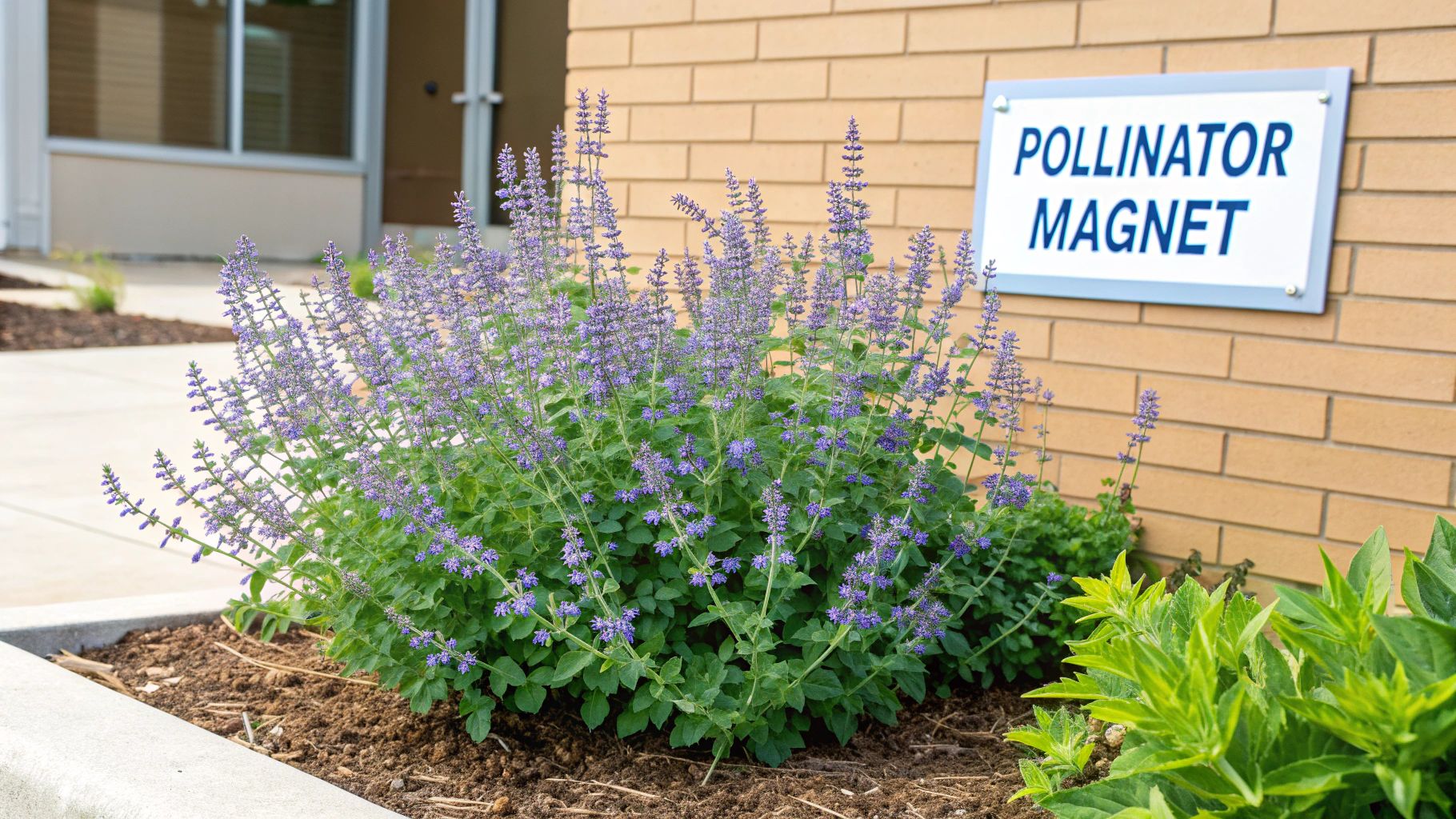
Unlike its more famous relative, catnip, most ornamental Catmint varieties have little to no effect on felines but are incredibly valuable in the landscape. Cultivars like 'Walker's Low' are widely used in public and private gardens for their toughness and graceful appearance, typically reaching a height and spread of 12 to 24 inches. This manageable size makes Catmint ideal for lining sunny borders, accenting rock gardens, or mass planting on slopes.
Why Choose Catmint?
The main appeal of Catmint is its unbeatable combination of beauty and durability. It is exceptionally drought-tolerant once established, making it a star performer in low-water gardens and xeriscaping projects. Its nectar-rich flowers are a magnet for pollinators, attracting bees, butterflies, and hummingbirds, which makes it a fantastic addition to any pollinator-friendly garden. The plant is also highly resistant to deer and rabbits due to its fragrant foliage.
Pro Tip: Plant Catmint along the edges of a hot, dry driveway or a south-facing wall where other plants might struggle. Its tolerance for heat and sun will allow it to thrive and soften harsh hardscapes.
Practical Tips for Growing Catmint
To ensure your Catmint performs at its best, follow these straightforward guidelines:
- Location and Soil: Plant in full sun for the most prolific blooms, although it will tolerate partial shade. It demands well-draining soil and performs poorly in heavy, wet, or overly rich conditions.
- Maintenance: After the first major flush of flowers begins to fade, shear the entire plant back by about one-third. This encourages a tidy shape and stimulates a second, and sometimes third, wave of blooms.
- Propagation: Catmint is easy to propagate. Healthy clumps should be divided every three to four years in the spring or fall to maintain vigor and create new plants. You can find out more about plant reproduction and learn how to propagate plants in water from our experts at homegrown-garden.com.
The following quick-reference guide summarizes the essential stats for growing Catmint.
| Key Characteristic | Details |
|---|---|
| Plant Type | Herbaceous Perennial |
| Sun Exposure | Full Sun to Partial Shade |
| USDA Hardiness Zones | 3-8 |
| Soil Type | Well-draining; Tolerant of poor soil |
| Bloom Time | Late Spring to Fall |
| Flower Color | Purple, Blue-Violet, Lavender |
| Mature Size | 12-24 in. tall, 18-30 in. wide |
| Special Features | Drought-tolerant, Deer resistant, Pollinator-friendly |
These key stats show why Catmint is a go-to for designers like Piet Oudolf and a staple in low-maintenance landscapes. Its ability to provide months of color with minimal input confirms its status as a reliable and beautiful perennial.
4. Verbena (Verbena species)
Verbena is a true garden workhorse, perfect for anyone looking to plant small purple flowers that bloom relentlessly from spring until the first frost. This diverse group includes both annual and perennial species, all known for their charming clusters of small, five-petaled blossoms. Their incredible blooming power and versatility make them a staple in gardens of all styles, from formal beds to naturalistic prairie plantings.
Verbena varieties offer a range of growth habits. Trailing types, such as the popular 'Homestead Purple', form dense, spreading mats of vibrant color, making them an excellent choice for groundcover, rock gardens, or spilling over container edges. Upright varieties, like the airy Verbena bonariensis, reach heights of 3 to 4 feet, creating a delicate, see-through screen of lavender-purple flowers on wiry stems that dance in the breeze. This habit allows them to be planted throughout a border without blocking the view of other plants.
Why Choose Verbena?
The primary appeal of Verbena is its exceptionally long bloom time and its drought tolerance once established. These plants are tough, resilient, and thrive in the heat of summer when other flowers may begin to fade. Their ability to attract a wide array of pollinators, including bees, butterflies, and hummingbirds, adds valuable ecological function to their aesthetic beauty, making your garden a lively and beneficial habitat.
Pro Tip: For a stunning, low-maintenance combination, pair the tall, airy Verbena bonariensis with ornamental grasses. The fine texture of the grasses complements Verbena’s delicate flowers, creating a soft, naturalistic look.
Practical Tips for Growing Verbena
To ensure your Verbena performs its best and provides a continuous floral display, follow these key tips:
- Sun and Soil: Plant Verbena in a location that receives at least 6 to 8 hours of direct sunlight daily. They require very well-draining soil and can be prone to root rot in heavy, wet conditions.
- Air Circulation: Space plants appropriately to ensure good air circulation, which helps prevent fungal diseases like powdery mildew, a common issue for some varieties.
- Maintenance: While many modern cultivars are self-cleaning, deadheading spent flower clusters will encourage even more prolific blooming. A light trim in mid-summer can also rejuvenate tired-looking plants.
- Watering: Water at the base of the plant to keep the foliage dry. While drought-tolerant, consistent moisture will yield the best flower production.
For gardeners interested in perennials, understanding the specific needs of different purple-flowering plants is key. For more in-depth information, you can explore this guide on purple perennial flower identification.
5. Creeping Phlox (Phlox subulata)
For a breathtaking display that blankets the ground in a sea of color, Creeping Phlox is a must-have perennial. Also known as Moss Phlox, this North American native is famous for creating spectacular carpets of small purple flowers in early to mid-spring. It forms dense, evergreen mats of fine, needle-like foliage that become completely obscured by a profusion of vibrant, five-petaled blooms.
Creeping Phlox has a low-growing, spreading habit, typically reaching just 4 to 6 inches in height but spreading up to 2 feet wide. This growth pattern makes it an outstanding choice for rock gardens, cascading over stone walls, or covering sunny slopes where it helps with erosion control. The purple varieties, such as 'Emerald Blue' or 'Purple Beauty', offer a vivid, electric hue that signals the true arrival of spring.
Why Choose Creeping Phlox?
The primary appeal of Creeping Phlox is its sheer flower power and rugged durability. It delivers a short but incredibly intense show in the spring, offering a high-impact visual with very little maintenance required. As a drought-tolerant perennial, it is perfect for beginner gardeners or for difficult, sunny spots in the landscape where other plants might struggle. Its evergreen foliage provides year-round interest, keeping the garden looking structured even after the blooms have faded.
Pro Tip: Plant Creeping Phlox on a slope or terraced garden bed. Its cascading habit will create a stunning waterfall of purple that maximizes its visual impact during the bloom season.
Practical Tips for Growing Creeping Phlox
To ensure your Creeping Phlox thrives and produces a dense floral mat, follow these simple tips:
- Planting: Space plants about 18 inches apart to allow for spreading. Plant them in full sun to guarantee the most prolific flowering.
- Soil and Water: This plant demands well-draining soil and will not tolerate "wet feet." Once established, it is quite drought-tolerant, but be sure to water it during extended dry periods.
- Maintenance: To encourage dense growth and a tidy appearance, give the plant a light shearing right after it finishes flowering. You can divide the clumps every few years to rejuvenate them and propagate new plants.
If you are interested in a native plant that offers a spectacular, low-maintenance bloom, Creeping Phlox is an excellent choice. Its ability to cover large areas with vibrant purple makes it a standout groundcover. To understand more about when this and other native flowers bloom, you can learn more about wildflower bloom times to plan your garden's color sequence throughout the seasons.
6. Johnny Jump Up (Viola tricolor)
For gardeners looking to plant small purple flowers bursting with personality, the Johnny Jump Up is an unbeatable choice. This cheerful, cool-weather annual or short-lived perennial is known for its distinctive blooms, which feature a charming tri-color pattern of purple, yellow, and white. As a European wildflower that has happily naturalized across North America, it brings a touch of untamed cottage garden charm wherever it grows.
Johnny Jump Ups grow into neat, low mounds, typically reaching 6 to 8 inches in height. Their petite flowers, often described as having little "faces," pop up in abundance during the cool seasons of spring and fall. This makes them a perfect companion for early bulbs like tulips and daffodils or for filling in gaps in borders, rock gardens, and containers. They readily self-seed, meaning you’ll often be greeted by their delightful blooms in unexpected places year after year.
Why Choose Johnny Jump Up?
The main appeal of Johnny Jump Up lies in its easy-going nature and whimsical appearance. It’s an excellent plant for beginners and those who appreciate a more naturalistic, self-sustaining garden. Furthermore, its flowers are edible, boasting a mild, wintergreen-like flavor, making them a popular choice for garnishing salads, desserts, and drinks. This dual-purpose beauty adds both visual and culinary value to your garden space.
Pro Tip: Let a few plants go to seed at the end of their blooming cycle. The seeds will scatter and germinate on their own, ensuring a continuous and charming presence in your garden for years to come.
Practical Tips for Growing Johnny Jump Up
To get the most from these delightful plants, follow these straightforward guidelines:
- Sowing: Direct sow seeds in the garden in early spring or fall. They prefer cool soil to germinate, so planting them before the weather gets too hot is key.
- Soil and Sun: They thrive in full sun to partial shade in rich, well-draining soil. In hotter climates, providing afternoon shade will help prolong their blooming period and prevent them from wilting.
- Maintenance: Johnny Jump Ups are incredibly low-maintenance. Keep the soil consistently moist, and remove spent flowers (deadhead) to encourage more blooms. Harvesting the flowers regularly for culinary use achieves the same purpose.
The following quick-reference guide summarizes the essential stats for growing Johnny Jump Up.
| Characteristic | Details |
|---|---|
| Plant Type | Annual or short-lived perennial |
| Sun Exposure | Full Sun to Partial Shade |
| Soil Type | Moist, well-draining, rich in organic matter |
| Bloom Time | Spring, Fall |
| Height | 6 - 8 inches |
| Width | 4 - 6 inches |
| Hardiness Zones | 3-9 (often grown as an annual) |
These key stats show how versatile Johnny Jump Ups are, thriving in cool conditions when many other flowers are just beginning to grow. Their self-seeding habit and edible nature make them a truly unique and rewarding addition to any garden.
Comparison of 6 Small Purple Flower Plants
| Plant | Implementation Complexity 🔄 | Resource Requirements ⚡ | Expected Outcomes 📊 | Ideal Use Cases 💡 | Key Advantages ⭐ |
|---|---|---|---|---|---|
| Sweet Alyssum | Very easy to grow, minimal care | Low – well-draining soil, regular watering initially | Continuous fragrant blooms from spring to fall | Edging, ground cover, containers | Fragrant, attracts beneficial insects, drought tolerant, self-seeding |
| Lavender | Moderate – requires pruning and good drainage | Moderate – full sun, well-drained soil, pruning needed | Long-lasting fragrant spikes, essential oil production | Herb gardens, aromatherapy, ornamental | Versatile uses, drought tolerant, long-lived perennial |
| Catmint | Low – minimal pruning and dividing | Low to moderate – full sun to partial shade, dry soils preferred | Extended blooming period with low maintenance | Pollinator gardens, xeriscaping | Long blooming, deer resistant, drought tolerant |
| Verbena | Low to moderate – deadheading recommended | Moderate – good air circulation, water at soil level | Long blooming from spring to frost, butterfly attractor | Borders, containers, butterfly gardens | Heat and humidity tolerant, versatile growth habits |
| Creeping Phlox | Moderate – requires division and shearing | Low to moderate – full sun, well-drained soil | Spectacular spring carpet of flowers, evergreen foliage | Rock gardens, slopes, groundcover | Evergreen, erosion control, cold hardy, dramatic spring color |
| Johnny Jump Up | Very easy – self-seeding annual | Low – tolerates partial shade, cool weather | Cool-season blooms with edible, colorful flowers | Cottage gardens, edible flower gardens | Edible flowers, cool weather bloomer, self-seeds readily |
Start Your Purple Palette Today
Embarking on a mission to plant small purple flowers is more than just adding color to your garden; it's an exercise in creating depth, texture, and ecological harmony. Throughout this guide, we've explored six exceptional varieties, each offering a unique personality to transform your green spaces. From the honey-scented carpet of Sweet Alyssum to the resilient, ground-hugging Creeping Phlox, the common thread is their ability to deliver a powerful visual impact in a compact form. These plants are not just pretty faces; they are hardworking garden allies.
The journey from a bare patch of soil to a vibrant display of purple blooms is a rewarding one. We've seen how the aromatic allure of Lavender and Catmint can create a sensory experience, while the cheerful faces of Johnny Jump Ups add a touch of playful whimsy. Each plant, with its specific needs for sun, water, and soil, offers a new lesson in horticulture. Mastering their care is a stepping stone to becoming a more confident and intuitive gardener.
Key Takeaways for Your Purple Garden
To ensure your success, let's revisit the most crucial insights for cultivating these purple wonders:
- Sunlight is Paramount: Most of these selections, including Verbena and Creeping Phlox, thrive in full sun. Proper placement is the first and most critical step to ensure vigorous growth and abundant flowering.
- Drainage, Drainage, Drainage: From Lavender's Mediterranean roots to the rock garden preference of Phlox, well-draining soil is a non-negotiable requirement. Amending heavy clay soils with compost or sand will prevent root rot and promote healthy development.
- Strategic Pruning Encourages Blooms: Don't be shy with the shears. Regularly deadheading Verbena and giving Catmint a mid-season "haircut" will stimulate a second flush of flowers, extending the purple display well into the later months of the growing season.
Your Action Plan for Planting Small Purple Flowers
Feeling inspired? Here are your immediate next steps to bring this vision to life. First, assess your garden space. Identify areas that receive at least six hours of direct sunlight and have good soil drainage. Next, decide on the role you want these plants to play. Are you designing a low-maintenance border, a fragrant container garden for your patio, or a pollinator-friendly patch to support local wildlife?
Once you have a plan, you can confidently select the plants that best fit your vision and environment. Remember, the beauty of gardening is in the process. Each seed you sow is an investment in future beauty and a commitment to nurturing nature. The simple act to plant small purple flowers can connect you more deeply to the seasons and the simple joys of watching something grow. It’s an accessible project for any skill level that promises a rich reward of color, fragrance, and life.
Ready to start your horticultural masterpiece? Find high-quality, non-GMO heirloom seeds for all the varieties mentioned here and more at Homegrown Garden. Our comprehensive grow guides and premium seed collections provide everything you need to cultivate a stunning garden filled with vibrant, small purple flowers. Homegrown Garden is your trusted partner for a successful and beautiful growing season.

